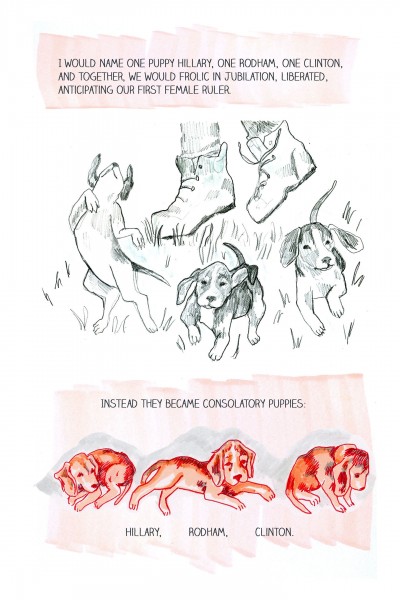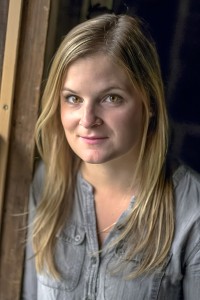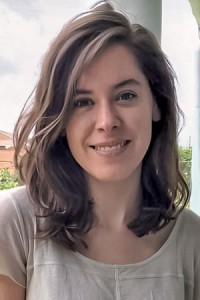Profound Puppies
Ohio Wesleyan Professor, Alumna Collaborate on Newly Published Graphic Essay

When Ohio Wesleyan University professor Amy Butcher agreed to foster three abandoned puppies, she expected a fuzzy, adorable experience.
It was November 2016, and Butcher happily dubbed the beagle-lab mixes “celebratory puppies,” naming the three females “Hillary,” “Rodham,” and “Clinton.” Then the presidential election happened, and the animals suddenly became “consolation puppies.”
Butcher, an OWU assistant professor of creative nonfiction, has since turned the true tale into a graphic essay featuring illustrations by Ohio Wesleyan alumna Martha Park ’11. The resulting collaboration, “Consolation Puppies,” was published this month in Granta, one of the most well-established and respected journals in the international literary community.
“We’re really pleased,” says Butcher, who began talking with Park after the election about collaborating “on an evocative, emotional piece that conveyed the sense of displacement and disappointment we both felt.”
Park says the project grew organically from those conversations, though the two still have yet to meet in person.
“I wanted to try out more graphic essays, and I loved Amy’s work,” says Park, a double-major in studio art and English with a concentration in creative writing. “Her essay about the painful, disorienting days immediately following the 2016 election was so meaningful and heartfelt and lent itself perfectly to illustration.”

Butcher says despite the fact this is her first graphic essay, she hopes to explore the art form further.
“I’ve long admired the form,” says Butcher, “but I possess absolutely no artistic talent, which I joke with my students is one of the values of a liberal arts education: Go take an art class! Or whatever medium or subject you wish you knew more about or possessed the skills for.
“I think the power of the graphic essay comes both in the sparse, concentrated use of text and the visceral images, which work not only to convey the plot but to instill and evoke emotion,” says Butcher, who joined the OWU faculty in 2014. “There’s an emotional resonance in a graphic essay that I find unparalleled in other versions of the essay form, and collaborating with Martha was all the more powerful because it required Martha to interpret my writing and create something new based on how the text made her feel, which was uniquely rewarding and illuminating for me as the writer.”
Park, who lives in Memphis, says she initially tried to illustrate each page by hand, but the process was taking too long.

“Then I realized I could draw the images by hand but compose each page digitally, and basically learned how to do that – use PhotoShop, integrate digital technology – as we went along,” Park says. “All told, from our initial conversations to publication, the project took probably about a year. ... It was a really natural process and I think a kind of release for both of us. This essay felt like a secret, precious thing that the two of us could indulge and bring to life.”
Granta readers aren’t the only ones to benefit from the collaboration and from Butcher’s foray into the graphic essay. Her OWU students are learning more about the genre, too.
“I recently developed and proposed a temporary course offering, ENG 100.5 Graphic Literature, which I intend to propose as a permanent course offering soon,” Butcher says. “The course examines the role and value of graphic narratives – fiction and nonfiction – and culminates both in a field trip to the Billy Ireland Cartoon Museum on Ohio State’s campus (the largest comic library in the world) and a final project where students are required to make their own autobiographical graphic narrative.
“We read texts that explore – through comic form – the Holocaust (‘Maus’), the Islamic Revolution (‘Persepolis’), and one woman’s beautifully devastating coming out narrative and attempt to understand her father (‘Fun Home’), plus individualized essays and self-contained shorter works,” Butcher says of the class. “Students don’t expect those subjects to manifest in the graphic form. So it’s a course that demands rigorous interpretation of graphic mediums and incredible willingness to pursue self-expression creatively.”
Like Butcher, Park also plans to continue exploring the genre and other formats that draw upon both her English and arts background. Her work already has been published in Ecotone, The Atlantic’s “CityLab,” Image, Gravy, Paper Darts, The Common, Terrain.org, the OnBeing podcast blog, and elsewhere.
“What’s next for me is what’s always next,” Park says, “more writing, more drawing, as much as I can. This was a really fun, meaningful first attempt at combining images and text. I’d love to keep collaborating with Amy and other writers, as well as illustrating my own pieces. I’ve been working on illustrated journalism – examples of which can be found in CityLab – that focus on housing in America, from urban renewal to the end of public housing to the affordable housing crisis.”
As for Butcher, she is working on her second book, “MOTHERTRUCKER,” about the nation’s only female ice road trucker, a woman who – until just recently, when she was tragically killed on the road – went by the handle “Joy Mothertrucker.”
“I spent much of my sabbatical shadowing Joy Mothertrucker on the James W. Dalton Highway – or ‘ice road’ – which is a 400-mile stretch of gravel that extends from Fairbanks, Alaska, north to the Arctic Ocean. It has been called ‘the most isolated road in America,’ ‘the loneliest road in America,’ and ‘the most dangerous road in America,’ and it was there, tragically, that Joy lost her life four weeks ago, just four months after our trip up that road together.”
Butcher’s first book, “Visiting Hours: A Memoir of Friendship and Murder,” tells the true story of a 2009 stabbing when a college friend of Butcher’s walked her home on a spring night and hours later fatally stabbed his girlfriend.
Butcher’s essays have been featured on National Public Radio and the BBC and published in Harper’s, The New York Times “Modern Love,” The New York Times Sunday Review, The Washington Post, The Denver Post, The Iowa Review, and many more.
Though speaking about “Consolation Puppies,” Butcher touches upon a central theme of her creative writing when she says, “I could turn that pain into art, which is why I’ve long pursued writing in the first place.”
Learn more about Butcher, Ohio Wesleyan’s Department of English, and its creative writing concentration at www.owu.edu/english.
